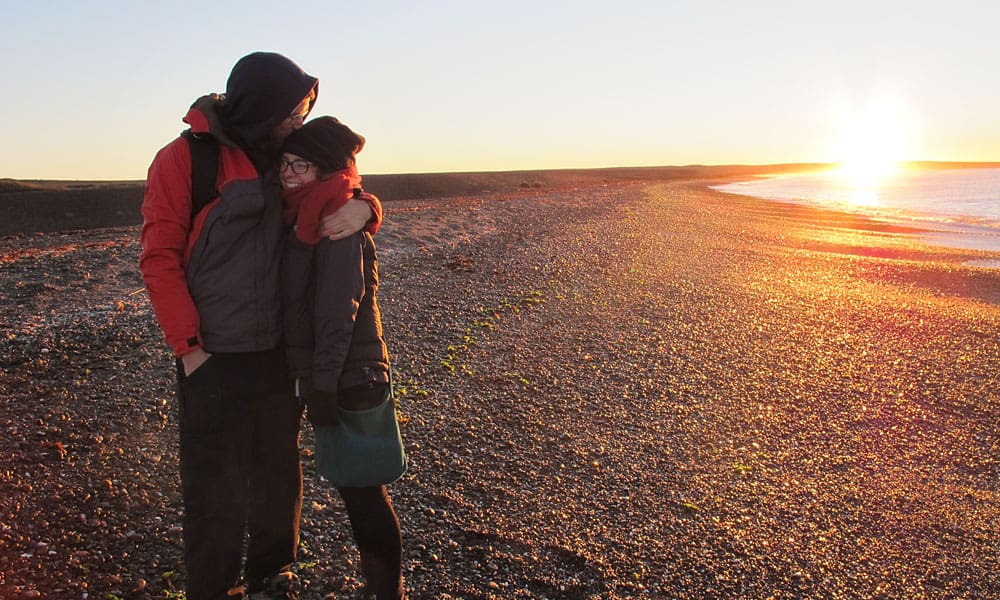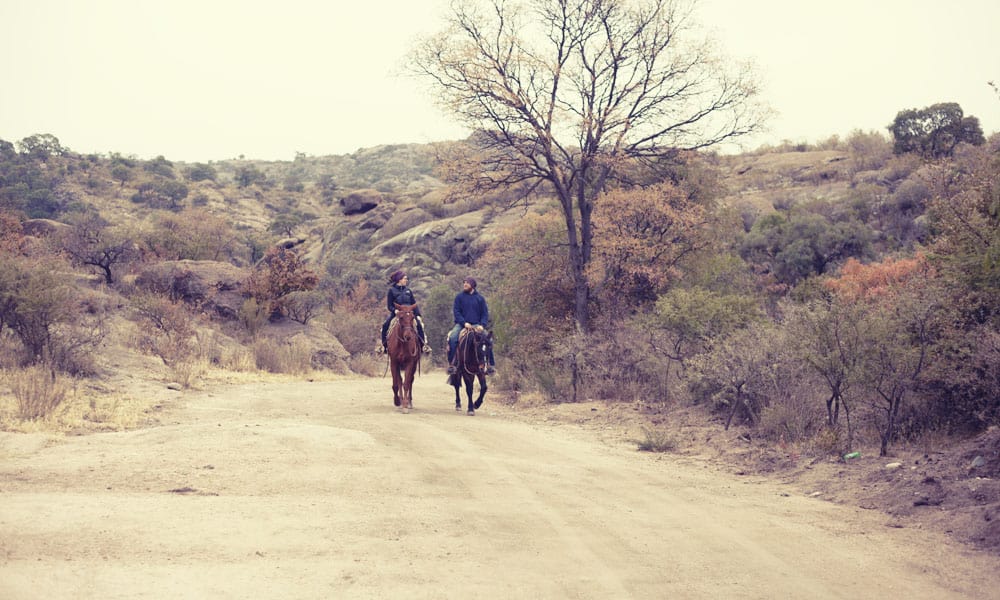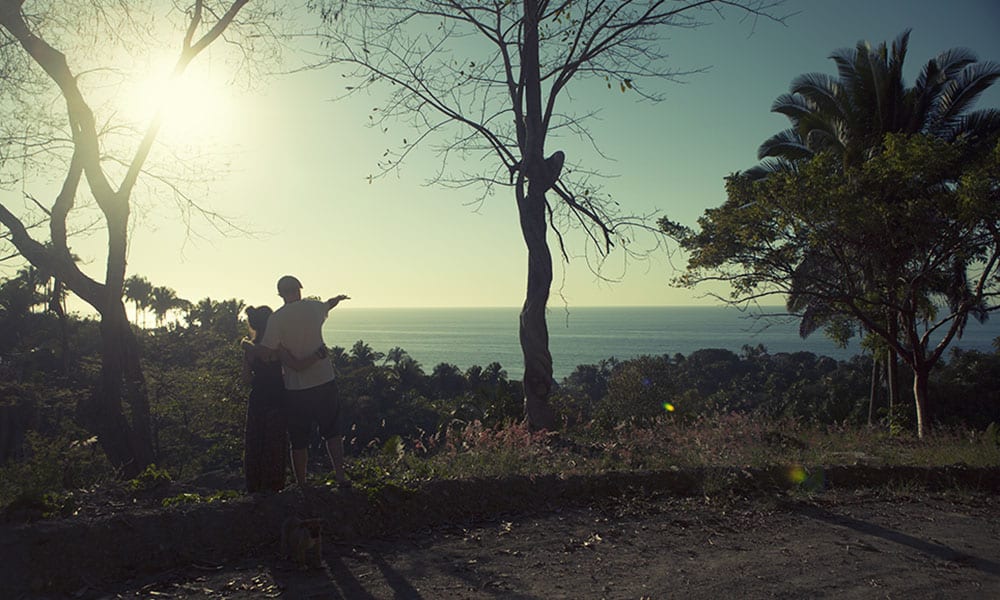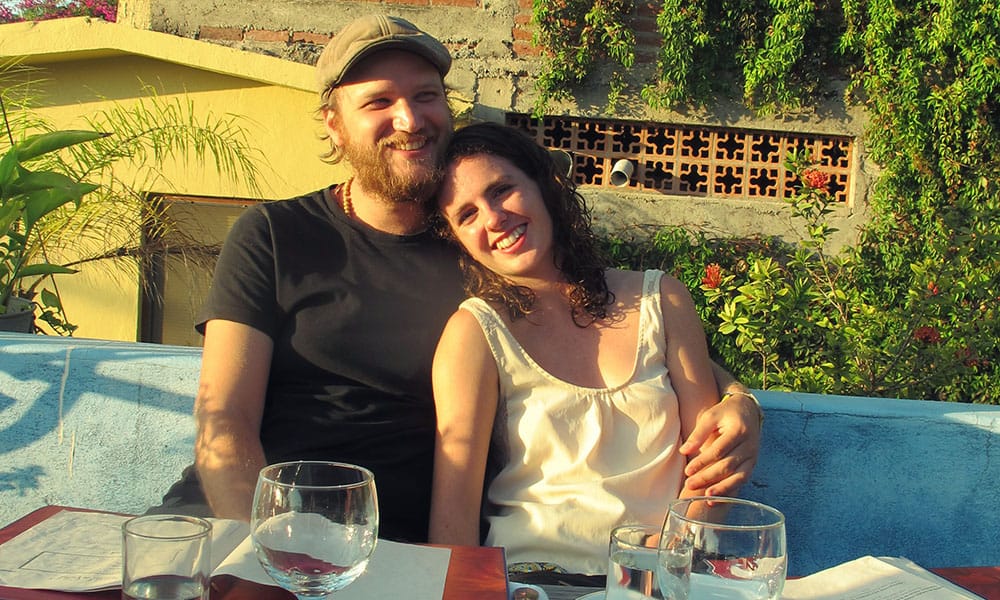This page contains affiliate links. Please read our disclosure for more info.
Victoria and Steve from Bridges and Balloons are two of our favourite travel bloggers. They not only write thoughtful, moving posts about permanent travel, life and more, but are also working on an incredibly ambitious and inspiring film project, and happen to be very lovely people. They are the reason that we lived in San Pancho in Mexico for three months and have put the tiny beach town on the map.
1) How long have you been travelling and where have you been?
Victoria: We’ve been traveling since March 2012. For the first leg of our travels, we went to Brazil, Argentina, Chile, Bolivia, Peru, Ecuador and Mexico. As you know, six months of that time was spent in the lovely San Pancho, and we also spent some longer stints in Buenos Aires, Salta and Vilcabamba. During that year, Steve also went to India and the USA to do some filming, and I went to Spain and Portugal for some conferences. We then went back to England for six weeks in May/June and are now in Bali where we’ll stay for five months. We’re definitely more suited to slow travel.
2) What made you decide to become digital nomads?
Victoria: Quite simply, we wanted to explore – the world, our options and our minds. When we left the UK, we had a vague notion that one day we might want to settle down somewhere, and we wanted to travel before that day came, perhaps even finding the location somewhere along the way. I had a great job, working as a writer for the Red Cross, but I hated working in an office, and also knew it wasn’t quite the job for me. Steve was doing the same as he does now and realized he could take that career on the road. Quite soon, I realized I could also work while travelling.
Nowadays, we’re not travelling with a view to settling down. We jostle various options – opening a retreat centre, spending half the year in one place, the other half travelling, spending time in the UK, not spending time in the UK, etc… The only thing that is clear right now is that we are happy doing what we do and have no idea how that might progress. We’re learning to live in the moment.
3) How do you fund your travels?
Victoria: We own a house in London, which we bought with inheritance money, and have now rented out. That income covers us in some of the cheaper places, but we also have to supplement it with savings and earnings. The aim is to not use that money at all. In the last six months, we’ve started to earn a little through advertising on the blog, and I do some freelance writing. That’s enough to cover about half our expenses. Steve is flat out working with Planetary Collective on Continuum, which doesn’t earn him anything right now, but will hopefully pay off eventually! While in San Pancho, I also taught yoga on a donation basis, which earned me anything from money to massages to homegrown veg. I really enjoyed living that way.

Victoria: Yes, so hard! But it’s something we are definitely getting better at. I had a wake-up call when I did a yoga teacher training course in the jungle in Mexico. The month-long break from the computer and the internet made me realize how important time offline is for me. Before that, I was prone to working 12-hour days hunched at the computer screen and getting lost in social media. Since then, my balance has improved, but it’s not perfect. I try to plan my days better so I don’t waste so much time online, and I also try to do yoga every day and look after my health generally (easily done in Ubud!).
Steve has a harder time with the balance as he has so much pressure on him right now. He has one day off a week, which we spend together doing more travelly stuff, like exploring the local area. That’s one of the joys of travelling and working – even if you only have one day off a week, you get to spend that day doing things like visiting tropical islands, or getting a super cheap massage. The one thing that has definitely made our work/travel balance easier is taking a slow approach to travel, and staying in one location for months at a time. When we’re on the move, it’s a hundred times harder.
5) Tell us more about Continuum, the film you are working on.
Steve: Continuum is a feature documentary about the future of life on this planet. To explore the possibilities for our future, we’re taking the viewer deep into our shared cosmic origin, through biological and social evolution up to the present crises facing us. On one level, the problems we’re facing are technological, social, and political, and there are corresponding, essential solutions that exist on these levels, but we are reframing these crises as a crisis of perception. To create a truly planetary culture is not just a question of smart grids and permaculture and horizontal organization, but of how we see each other, the world, and the wider cosmos.
What happens when we start to experience ourselves as inseparable from the continuum of energy, matter and life? How can we embed this understanding into our culture? What would a planetary civilization look like?
To explore these questions, we’ve interviewed some incredible people – astronauts, poets, storytellers, great teachers, ecologists, activists, etc. and we are still shooting the interviews now. I’m currently editing these amazing peoples’ ideas together here in Ubud. It’s a vast, and at times daunting task, but incredibly exciting and inspiring to be part of something like this.
It will be released at the end of February 2014.

6) Planetary Collective managed to successfully raise over $80,000 in funding for the film on Kickstarter. Any tips on running a successful Kickstarter campaign?
Steve: I’m actually planning to give a talk on this subject at the Hubud (a co-working space) in Ubud pretty soon because I’ve got a fair bit to say about this, but there are some definite basics:
Build and prime your audience before you start the campaign using all the social media channels you’re comfortable/competent with. If you already have a successful blog, you’re in good stead, but get people excited about the project before you launch.
Make sure you get the amount you’re asking for right – don’t make the mistake some do of not factoring in the percentages Amazon and Kickstarter take, and the costs of making your pledges.
Think carefully about how long you run the campaign: you might think longer is better, but Kickstarter produced their own statistic showing that most successful projects run for 30 days (not 45 or 60 or more).
In our experience, it was tricky to get mainstream press involved in promoting/writing about the project – even people who had written about our previous work. They might write about the final product when it’s done, but seem disinclined to write about Kickstarter projects on the whole (with the possible exception of tech projects). Put the emphasis on blogs, people, friends, friends of friends etc.
Update as often as you can with new content – new pledges, new aspects of your story, photos etc. Keep people engaged.
Somewhere I remember reading this: “No matter how prepared you are for your Kickstarter campaign, it’s going to be a wild ride.” So true. One of the biggest mistakes you can make is to get lost in the ‘Field of Dreams’ – just because you build it does not mean they will come, no matter how genius your idea. I’ve now watched a few projects I’ve supported fail (some by people I know), and one of the primary mistakes seems to be in thinking you can just show up and the magic will happen.
It’s hard work. Plan it well, follow leads every single day, update, engage, push, share, win!
7) You are considering settling down for part of the year in San Pancho, Mexico. Tell us more about your plans and what made you fall in love with the town?
Victoria: Aw, San Pancho. We miss it a lot there. We discovered and fell in love with the town after I did my yoga teacher training in the jungle just outside. It’s a really special place – tiny, but with everything you need, and filled to the brim with wonderful people. We came very, very close to buying some land there and building a retreat centre, but finally decided to give the decision some time and see how it looked from afar. It’s definitely still a strong option, but we don’t want to rush into it. There are a lot of considerations and we’re not quite ready to make a choice yet. For now, we’re happy as we are.

8) Like us, you are both vegetarians. What are your favourite vegetarian-friendly destinations?
Buenos Aires was surprisingly brilliant, especially Palermo. It’s filled with amazing cafes and loads of veggie options. We’ve both lived in Barcelona and found some great gems there, and we think London may be one of the best cities in the world for vegetarians. Currently, we live in Ubud, Bali which is a health food mecca – definitely one of the best places we’ve ever been for vegetarians.
9) You are big fans of couchsurfing. What advice do you have for someone who’s intrigued by the idea but worried about safety?
When it comes to safety and couchsurfing, a lot of it comes down to common sense. All of the tools are in place to make it a safe experience so long as you use them. The most important thing of all is to check peoples’ references. I’ve known people to go and stay with someone even though they had a bad reference, and then be surprised that the same thing happened to them. Don’t ever get so desperate about the idea of having somewhere free to stay that you turn a blind eye to warning signs. For example, men who say they’d prefer a female couchsurfer, and have references that say they were lecherous should best be avoided! Neither of us have ever had any problems with safety and couchsurfing. We’ve surfed and hosted extensively and it’s provided some of the best experiences of our travels. We’d recommend it to anyone. I’m actually in the process of writing a ‘Couchsurfing 101’ e-book right now.
10) Where are you heading to next?
We’re here in Bali until the end of October when we go back to the UK for a wedding. We’ll only be there for about a week and then will likely head to Barcelona where Steve will complete the final post-production of the film with a studio out there. In fact, the studio is owned by the first person I ever couchsurfed with who went on to become a great friend.
You can follow Victoria and Steve’s adventures at Bridges and Balloons, on Twitter and on Facebook.
If you enjoyed this interview then read about other long term nomads in our Nomadic Interviews series.

Well story is amazing. Others are doing. we are dreaming. NEV is always my favorite blog. Particularly blog post about Japan is very well and informative. Appreciated
I love their blog and can’t wait for the documentary. Victoria, I totally get that back and forth about spending time in the UK and not spending time in the UK. I feel a similar feeling about the U.S. My heart and my wanderlust pull me in opposite directions.
Thanks for the interview and great learning about you guys! I must say it is a pleasure reading about how other people/family and couples are doing on their journeys and how they fund it. I think its great you were able to raise $80k. We are just starting to put our plan in place for our travels. Bali is some place I definitely what to take the family!
Wonderful article! I love their blog :) Looking forward to the ebook about Couchsurfing as well.